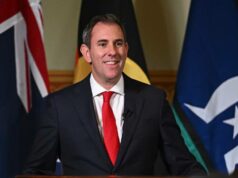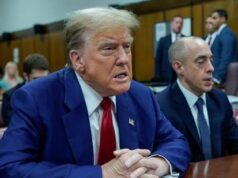What a Donald Trump second term would look like?

By Anthony Zurcher
Donald Trump has devoted much of this presidential campaign looking back, contesting his 2020 election defeat. But behind the scenes, he and his team are putting together a plan for power, determined to avoid the mistakes of 2016.
For those wondering what Mr Trump intends to do if American voters send him back to the White House in 12 months, the former president is laying it all out.
It’s there in bite-size chunks on his campaign website, it’s heard at his rally speeches and it’s documented by people he has entrusted to work on his second term preparations.
They call the plan Agenda47 – a reference to Mr Trump becoming America’s 47th president if he wins. He is favourite to win the Republican nomination, which would pit him against Democratic President Joe Biden next November.
Eight years ago, when Donald Trump launched his unlikely bid to win the White House race, he did so with a shoestring budget and a ragtag staff of political outsiders and hangers-on.
He had a slogan, Make America Great Again. He had a few tentpole policies, like building a border wall and temporarily banning Muslims from entering the US. And he had an anti-establishment, drain-the-swamp attitude.
After his upset victory, he set about turning his broad political vision into action – but with mixed results.
His “Muslim ban” was repeatedly struck down by courts, before finally becoming policy in its diluted form. His pledge to build a border wall was derailed by lawsuits and congressional Democrats.
It was, in the view of those in Mr Trump’s circle, a failure of preparation and a failure of personnel.
Those were mistakes they don’t intend to repeat if they win in 2024.
Moments after Mr Trump had given his inauguration speech on 20 January, 2017, he walked into the Oval Office at 6.55pm with Marc Lotter who worked on his transition team.
From the discussions that followed, Mr Lotter quickly realised the administration just wasn’t equipped to deal with “moving the Titanic-sized ship of government”, he tells the BBC.
This time, he and other veterans of the Trump presidency are making sure they are better prepared, he says, and they’re crafting a plan.
“Here’s a playbook. Here’s how you get it done. And here, most importantly, are the areas and the places and positions where a liberal bureaucracy is going to try to stop you.”
That playbook has revealed itself over the course of the year.
Some of his pronouncements border on the fantastical. His government will invest in flying cars and build “freedom cities” on empty federal land, where Americans can live and work without burdensome regulations.
Others are controversial, such as his plan to round up the homeless and move them to tent camps outside US cities until their “problems can be identified”. Some lean directly into the culture wars – he wants state school teachers to be required to “embrace patriotic values”.
He also doubles-down on protectionist policies, calling for a “universal baseline tariff” on all imports, which can be raised on countries that engage in “unfair” trade practices.
On immigration, he wants to reinstate the policy of making undocumented migrants stay in Mexico while they apply for asylum. He also calls for an end to automatic citizenship for the children of undocumented migrants born on US soil.
He pledges to cut “hundreds of billions” of dollars in US international aid and end the war in Ukraine in the process. According to media reports, he is contemplating a US withdrawal from Nato or, at the very least, scaling back American involvement with the trans-Atlantic defence pact.
“The greatest threat to Western civilisation today is not Russia,” he says in a March video. “It’s probably, more than anything else, ourselves and some of the horrible, USA-hating people that represent us.”
According to Mr Lotter, the top issue on Mr Trump’s 2024 agenda will be energy – increasing supply to bring down household bills.
In his view, higher energy prices have been a driving force behind the inflation that bedevilled the early years of the Biden presidency.
“Opening up the spigots and sending the signal to the markets and to the energy companies that we are open for business again will actually start to lower energy prices long term.”
These policies represent the culmination of Mr Trump’s efforts to remake the Republican Party in his own image.
The conservatism of George W Bush, John McCain and Mitt Romney – the party’s presidential nominees in the four elections prior to Mr Trump’s 2016 victory – has been swept away.
“The party has evolved, there’s no other way to say it,” says Bryan Lanza, a Republican strategist with ties to the Trump campaign. “We’re the party of tariffs now. Who would have predicted that?”
The new Republican Party, Mr Lanza says, blends conservatism with a populism that appeals to working-class voters, including labour workers who have traditional ties to the Democratic Party. Immigration, trade and a restrained foreign policy backed by American “strength” are core parts of the agenda now.
Many of Mr Trump’s proposals would require the help of legislation passed by a Congress that, at the moment, is partially controlled by Democrats vehemently opposed to his plans. Others, like ending birth right citizenship, probably violate the US Constitution and would certainly be challenged in the courts.
There are some, however, that are within his ability as chief executive to enact if he so desires – and if he has the cadre of loyal aides and government workers to do the job. And that’s one piece of the puzzle that Mr Trump has been preparing to address for quite some time.
In October 2020, just before he was voted out of office, Mr Trump issued an executive order creating a new category of civil servant. These “Schedule F” positions were senior policymaking roles that had traditionally been filled by career government bureaucrats. Under Mr Trump’s order, they could now be fired and replaced by the president and his senior political staff.
It would, in effect, allow a president to clear out thousands of government employees and replace them with loyalists.
Joe Biden quickly rescinded the order, but Mr Trump promises its reimplementation will be one of the first acts of his new presidency. In his campaign videos, and in public speeches, he boasts about what the change will accomplish.
He will “find and remove the radicals, zealots, and Marxists who have infiltrated the federal Department of Education,” he says in a January video.
“We will pass critical reforms making every executive branch employee fireable by the president of the United States,” he said in South Carolina rally last year. “The deep state must and will be brought to heel.”
Behind Mr Trump’s campaign apparatus are a number of organisations tasked with ensuring that Mr Trump’s vision is achieved.
With names like the Center for Renewing America and the America First Policy Institute – where Mr Lotter works – these groups, largely staffed by former senior Trump officials, are churning out position papers and documents that could offer a blueprint for implementing the policies Mr Trump has outlined over the past year.
The Conservative Partnership Institute, which lists former Trump Chief-of-Staff Mark Meadows as a “senior partner,” recruits, trains and finds employment for conservatives who could join a future Republican presidential administration. They’ve compiled a database of willing foot soldiers in the sweeping reorientation of the federal bureaucracy that Mr Trump hopes to accomplish.
It’s a development some of Mr Trump’s former aides, who have become his critics, fear.
“If Trump was elected to a second term, there wouldn’t be sound people around him,” says Cassidy Hutchinson, who served as a senior aide to Mr Meadows and testified against Mr Trump at the 6 January congressional hearings last year.
For Trump’s supporters, however, a more willing team of appointees and aides will mean a Trump presidency that is less chaotic and more effective in moving policy.
Mr Lotter envisions Mr Trump able to lay out in detail his plans upon taking office.
“Here are 50 policies, and here are 50 executive orders, and here are 1,500 positions I plan to fill,” Mr Lotter imagines Mr Trump saying. “And here’s my legislative package – to get energy back, to secure the border, to deal with inflation.”
Such talk is cause for hope and optimism among the Trump faithful, but spelling out a detailed agenda could also provide an opening for Democrats to attack.
“I think there is an opportunity to define Trump and his policy-wonks-for-hire friends as not only completely out of touch, but as determined to deny a majority of Americans their rightful place in American society,” says Craig Varoga, a Democratic political consultant and adjunct instructor at American University.
“And in some cases – abortion rights for example – [they want to] criminalise what many people consider to be reasonable freedoms.”
He also says it’s possible the always mercurial Trump could change his mind and discard all the policy proposals his advisers have prepared.
But Mr Lanza downplays that possibility because this team knows Mr Trump so well.
“These people are going to have the president’s trust from being in the administration, and they’ll have the inside track on having an impact,” he says. “Will the plan change over time? Of course. Plans change.”
As for Democratic efforts to attack Mr Trump’s agenda, Mr Lanza is dismissive. He says critics said the same thing about the former president’s campaign proposals in 2016.
“It scared people and it was provocative, but it still got people to listen to his core message,” he says.
“What President Trump does really well is he breaks the mould of how you think the electorate is going to respond to something controversial.”



